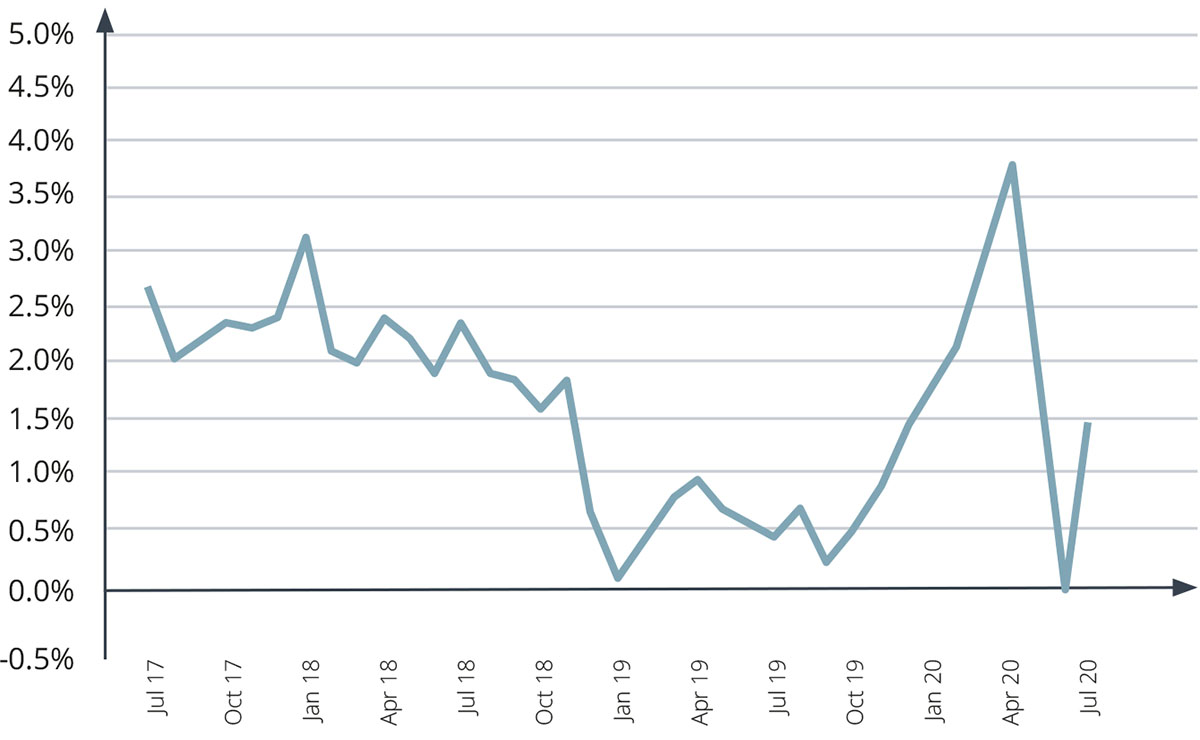Residential Property Review – August 2020
HOUSE PRICE RECOVERY CONTINUES
July saw house prices enter positive territory for the first time since March, with a net balance of 12% of respondents to Royal Institution of Chartered Surveyors (RICS) July UK Residential Market Survey reporting an increase, against -13% in June.
Meanwhile, Halifax reported a ‘mini-boom’ in house prices. Russell Galley, Managing Director at Halifax said: “The latest data adds to the emerging view that the market is experiencing a surprising spike
post lockdown. As pent-up demand from the period of lockdown is released into a largely open housing market, a low supply of available homes is helping to exert upwards pressure on house prices. Supported by the government’s initiative of a significant cut in Stamp Duty, and evidence from households and agents suggesting that confidence is currently growing, the immediate future for the housing market looks brighter than many might have expected three months ago.”
The central London residential market has suffered due to international travel restrictions, although prime outer London saw a 0.2% rise in house prices in locations such as Wandsworth, Dulwich and Islington and prices outside London have been more resilient since the market re-opened due to buyers looking for more space.
RECORD TENANT DEMAND
ARLA Propertymark’s latest Private Rented Sector (PRS) report shows strong activity, with the number of prospective tenants at a record high for June.
Per branch, an average of 79 new tenants were registered, up on June 2019’s figure of 71 and the previous month’s average of 70. However, numbers are still down on pre-lockdown figures, with an average 82 prospective tenants per branch recorded in February.
Meanwhile, rental supply continues to pick up, with an average of 200 properties managed per branch, a slight drop from the May figure of 208. Phil Keddie, Arla Propertymark President, commented on the figures: “The record-breaking supply of rental stock and demand from tenants for this time of year paints an optimistic picture for the summer months, indicating that the market will be more active than the usual seasonal lull.”
LONGER MORTGAGE TERMS: THE PRICE OF
AFFORDABILITY FOR FIRST-TIME BUYERS
Just under half of first-time buyers are opting for mortgage terms of 30 years or more to get on the property ladder.
Figures from the government’s latest English Housing Survey show that 45% of first-time buyers selected mortgages with terms of 30 years or more in 2018-19. A decade previously, on the other hand, this figure stood at 33%.
Despite putting down an average deposit of £42,361 on their property, this down payment constituted less than 20% of the property’s purchase price for over two-thirds of first-time buyers.
The high cost of buying a home continues to deter many from getting onto the property ladder – the survey found that only 56% of people living in private rented accommodation said they expected to buy a property in the future, compared with 61% when the same survey was carried out in 2013-14.
| “The latest data adds to the emerging view that the market is experiencing a surprising spike post lockdown.“ |
HOUSE PRICE INDEX JULY 2020
| HEADLINES | JUL-20 | JUN-20 |
|---|---|---|
| MONTHLY INDEX* | 435.9 | 428.8 |
| MONTHLY CHANGE* | 1.7% | -1.6% |
| ANNUAL CHANGE | 1.5% | 0.1% |
| AVERAGE PRICE (NOT SEASONALLY ADJUSTED) |
£220,936 | £216,403 |
* Seasonally adjusted figure (note that monthly % changes are
revised when seasonal adjustment factors are re-estimated)
- House prices down 1.7% month-on-month
- Annual house price growth recovers to 1.5%
ANNUAL PERCENTAGE CHANGE IN UK HOUSE PRICES

| “The bounce back in prices reflects the unexpectedly rapid recovery in housing market activity since the easing of lockdown restrictions.”
Robert Gardner, Nationwide’s Chief Economist |
Source: Nationwide, House Price Index, July 2020
OUT OF CITY EXODUS
Commenting on a shift in buyer priorities as people look to leave cities, Rightmove’s property expert, Miles Shipside said:
 “More property is coming to market than a year ago in all regions, and at a national “More property is coming to market than a year ago in all regions, and at a nationallevel the new supply and heightened demand seem relatively balanced. However, those expressing most desire to move on are unsurprisingly in London and its commuter belt. London has 69% more properties coming to market, with the South East at 60% and the East at 56%. With work and transport patterns potentially changing most around the capital, commuter-belt properties need to have more appeal to prospective buyers than just proximity to a station.“ |
Source: Rightmove August 2020
All details are correct at the time of writing (20 August 2020)
It is important to take professional advice before making any decision relating to your personal finances. Information within this document is based on our current understanding and can be subject to change without notice and the accuracy and completeness of the information cannot be guaranteed. It does not provide individual tailored investment advice and is for guidance only. Some rules may vary in different parts of the UK. We cannot assume legal liability for any errors or omissions it might contain. Levels and bases of, and reliefs from, taxation are those currently applying or proposed and are subject to change; their value depends on the individual circumstances of the investor. No part of this document may be reproduced in any manner without prior permission.
